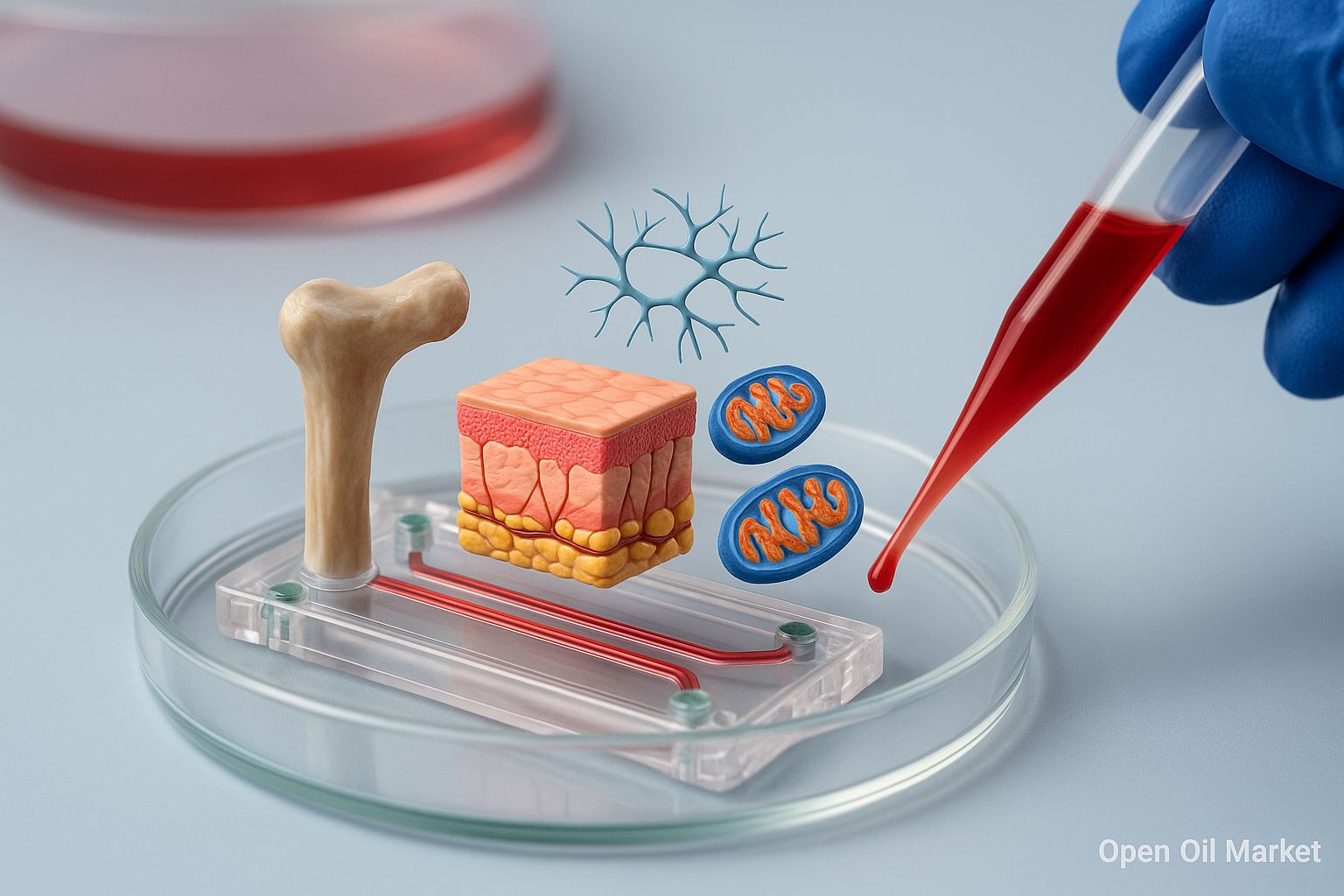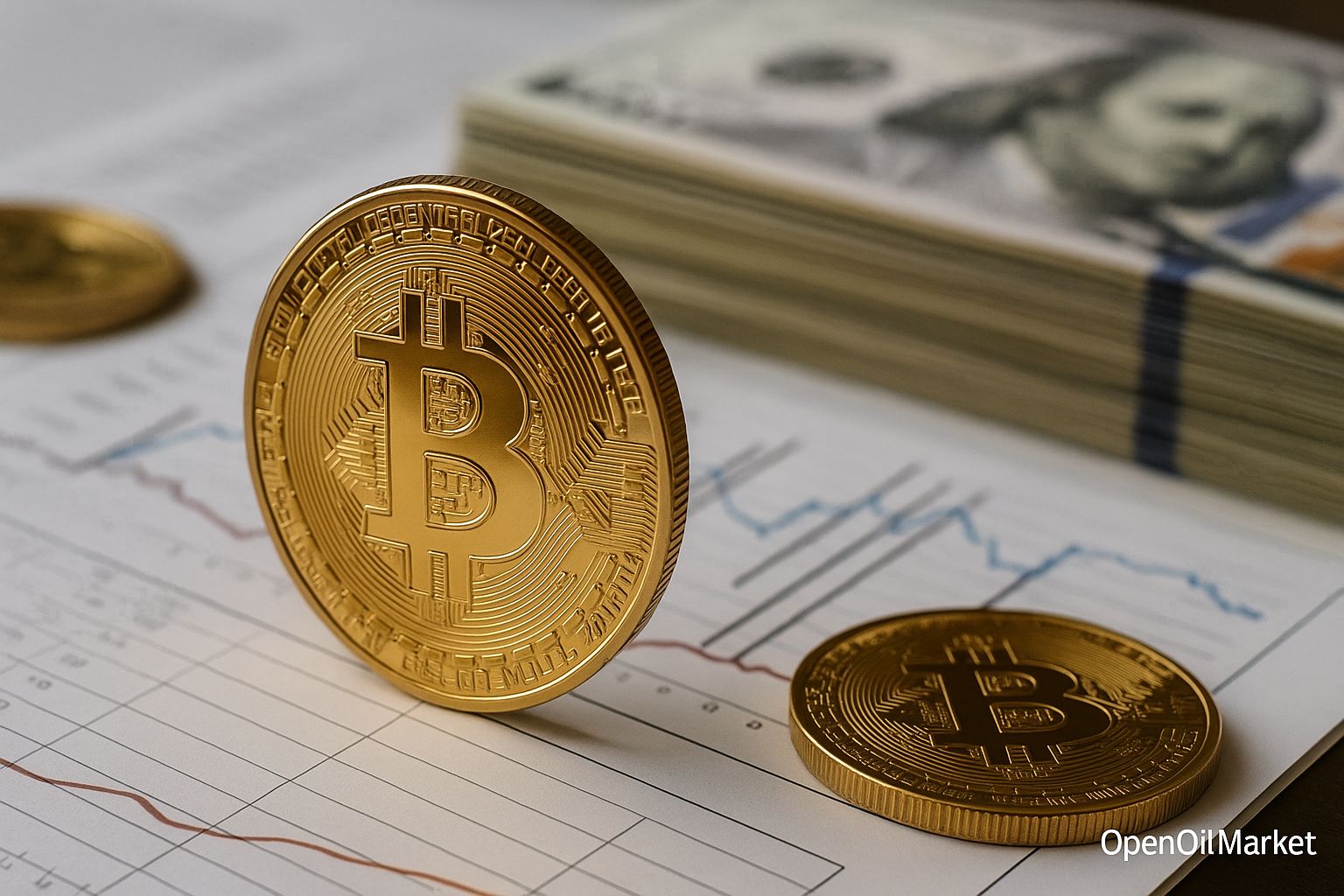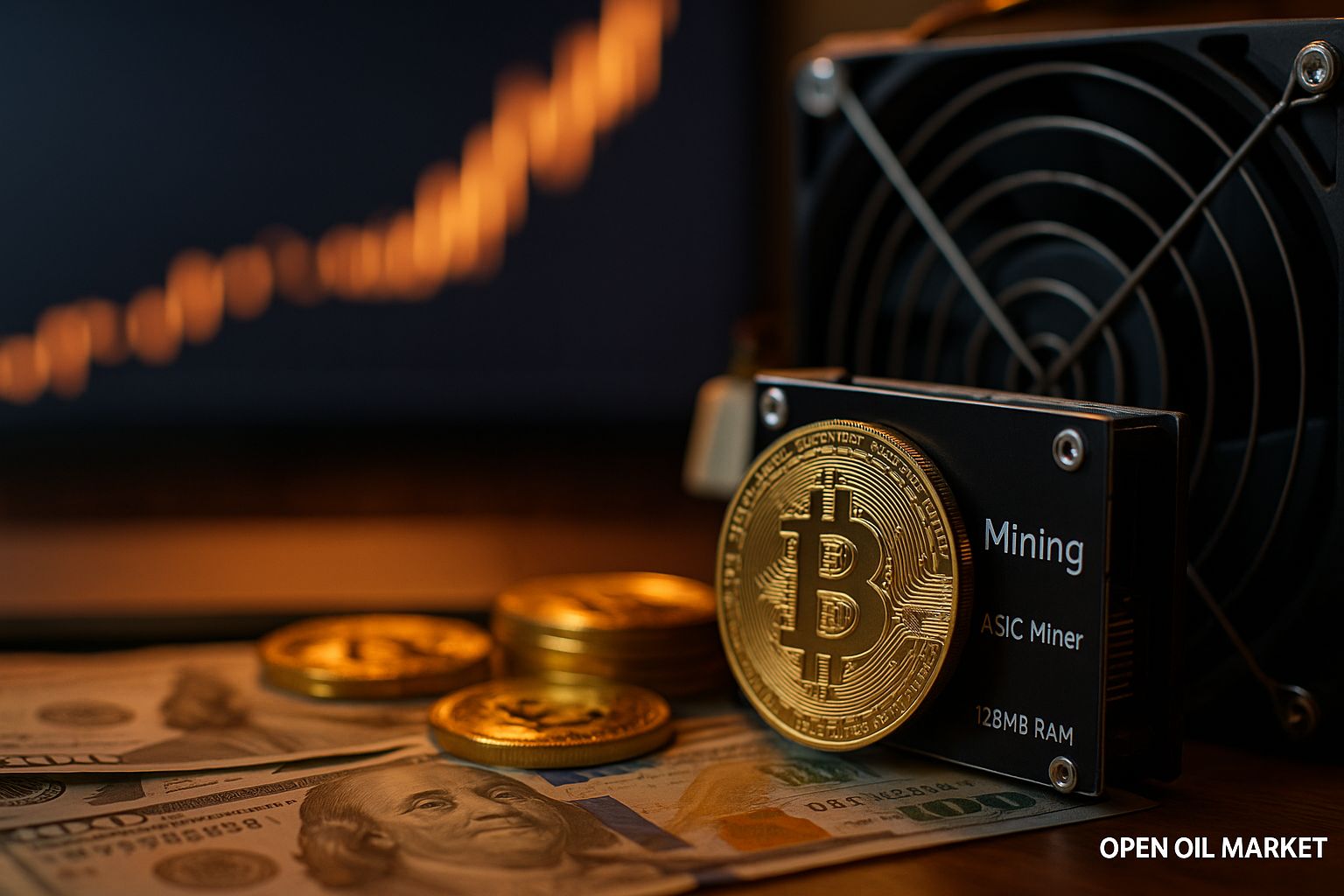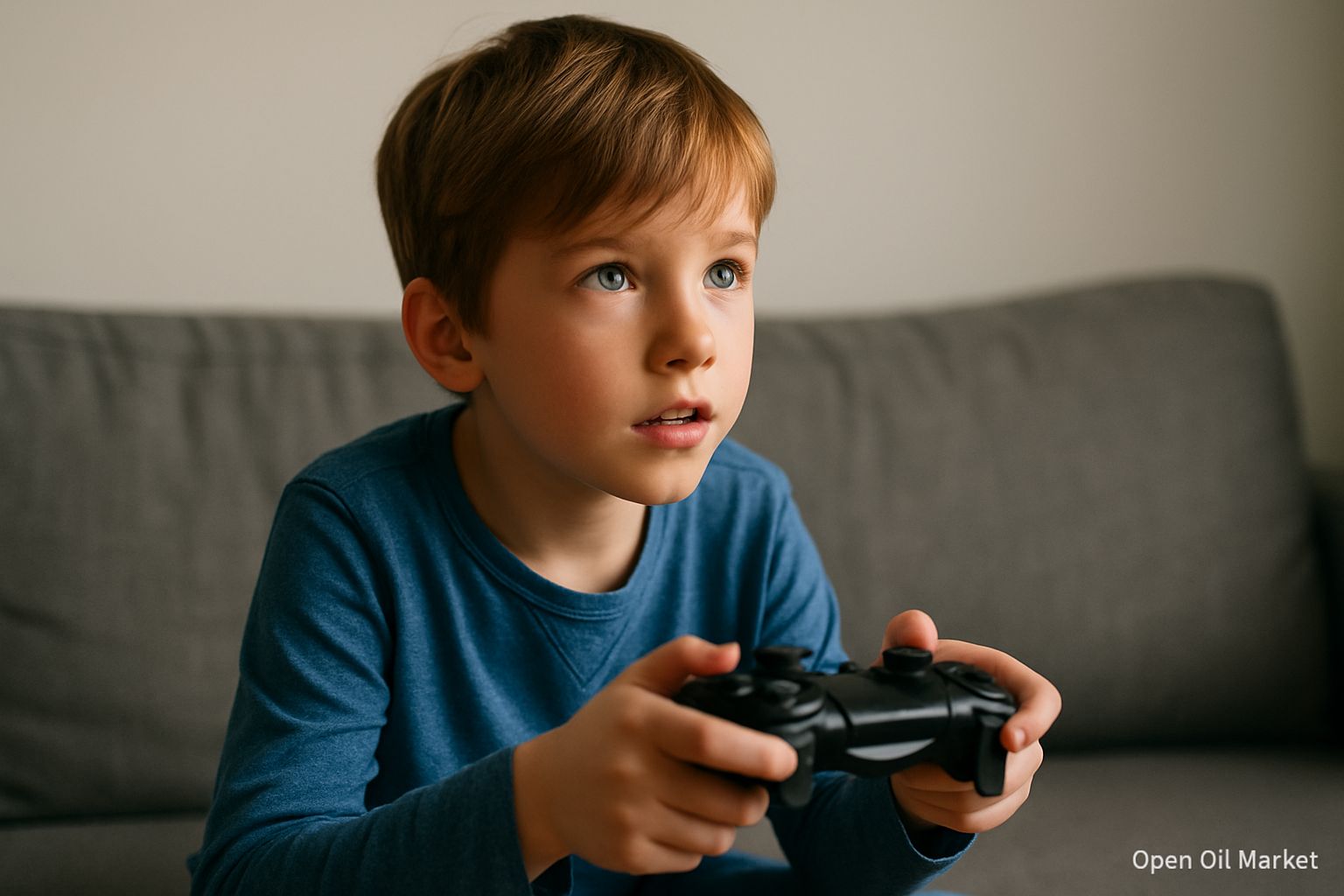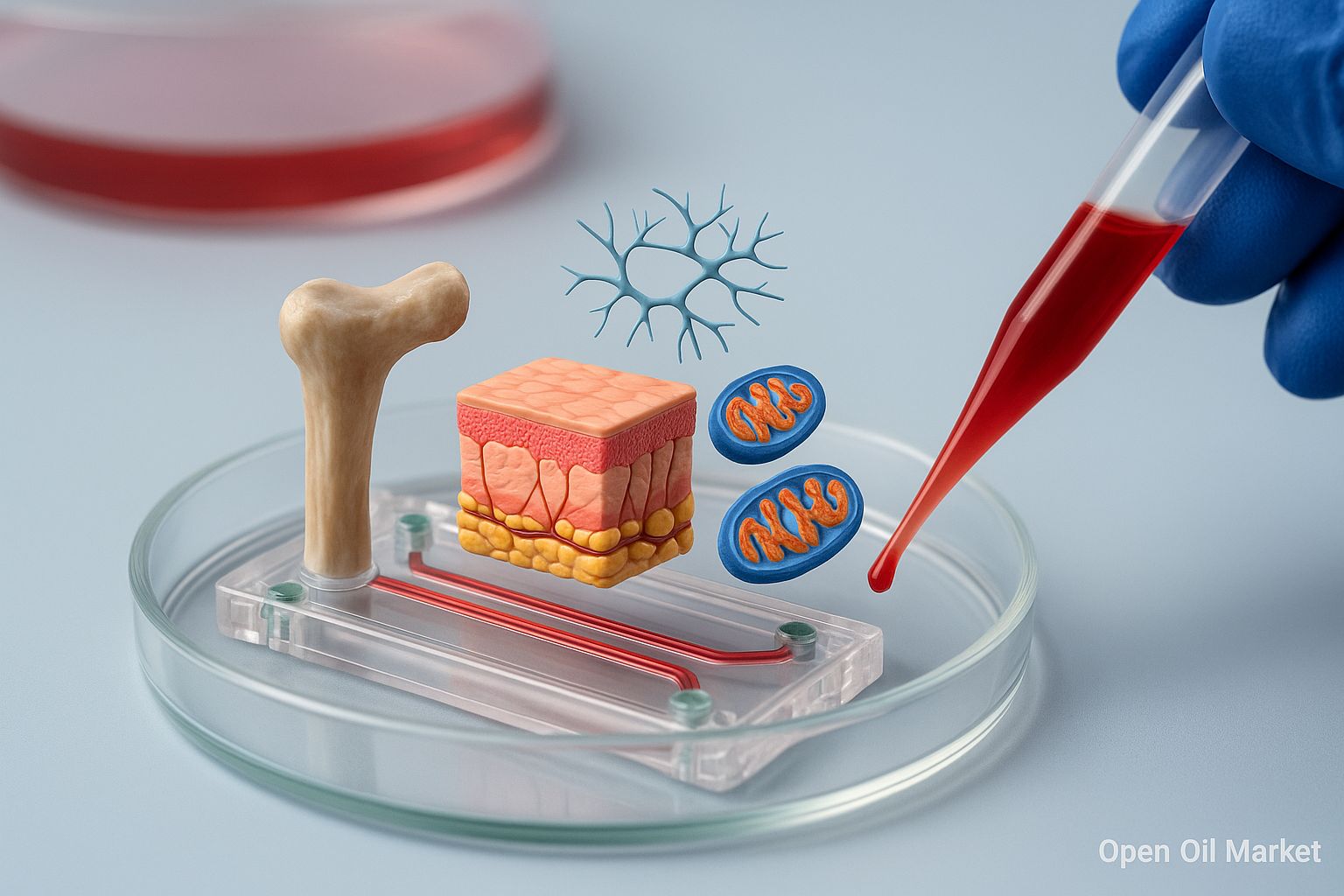
German Scientists Demonstrate on a "Organ-on-a-Chip" Model That Proteins Secreted by Young Bone Marrow Under Serum Influence Stimulate Skin Rejuvenation: Accelerating Cell Division, Increasing Collagen Synthesis, and Improving Mitochondrial Function.
German researchers have, for the first time, demonstrated on a human skin model that factors from the blood of young individuals can rejuvenate aging skin cells. However, noticeable rejuvenation was only achieved under one condition: bone marrow cells must be involved in the process. Without the "support" of the bone marrow, young blood serum alone provided no significant effect. These conclusions were drawn by a group of scientists led by experts from the R&D center of Beiersdorf AG (Germany) after conducting experiments utilizing an organ-on-a-chip. The research findings were published in the journal Aging in August 2025.
Microphysiological Skin and Bone Marrow Model
The experiment employed an advanced microphysiological system – essentially, an "organ-on-a-chip" mimicking organ interactions. The researchers combined an artificially grown model of human skin and a bone marrow model into a single circulating circuit. This system replicates the conditions of blood circulation: a nutrient solution (analogous to blood) continually circulates between the skin tissues and bone marrow cells, just like in the body.
In this system, samples of blood serum from two groups of donors were introduced: young (under 30 years) and elderly (over 60 years). The researchers observed how "young" and "old" serum affected the condition of the skin. It was found that the serum from young donors alone did not have the capacity to rejuvenate the skin – in isolated skin cultures, it did not induce improvements in structure or cell division rates. However, the picture dramatically changed when bone marrow cells were present in the system. During combined cultivation, the skin receiving young serum exhibited noticeable positive changes: the growth of new cells accelerated and its biological age decreased (as noted through epigenetic "clocks" measuring DNA methylation). In contrast, serum from elderly donors did not show such an effect. In other words, the rejuvenating potential of young blood was only unlocked with the participation of bone marrow.
Bone Marrow as a Key Mediator of Rejuvenation
Bone marrow plays an active mediating role, translating signals from the blood into tissue regeneration programs. This organ is the primary "incubator" of blood cells (hematopoiesis), containing stem cells and other precursors capable of releasing numerous signaling molecules into the bloodstream: cytokines, growth factors, and chemokines. In this study, it was the bone marrow cells that responded to the presence of young serum and began producing substances that trigger skin rejuvenation processes. Without the bone marrow, the skin simply "does not hear" the rejuvenating signals from the young organism.
The findings explain why earlier experiments with animals (such as connecting the blood flow of an old and young mouse) affected multiple organs at once. Bone marrow cells effectively act as "translators" of signals from young blood: they perceive systemic factors from the bloodstream and, in response, produce secondary signals that specific tissues – like the skin – understand. The researchers emphasize that rejuvenation is not just a direct action of blood components but a complex inter-organ process where the key role belongs to the bone marrow.
Proteomic Analysis: Searching for "Youth Proteins"
In order to determine which specific molecules the bone marrow releases in response to young blood, the team employed proteomic analysis methods. Utilizing mass spectrometry, the researchers analyzed the set of proteins secreted by bone marrow cells upon the addition of young and old serum. The results were quite revealing: in a "young" environment, the bone marrow began to produce dozens of specific proteins associated with rejuvenation.
A total of 55 candidates – proteins whose levels significantly increased in the presence of young blood when compared to old – were identified. Many of these are already known to science and have previously been discussed in the context of tissue regeneration, immune regulation, or skin remodeling. However, for practical application, it was crucial to understand which of these factors actually provide a rejuvenating effect. The researchers isolated seven key proteins and tested their effects separately on cultures of old skin cells. These seven factors confirmed their ability to significantly stimulate skin renewal.
Seven Key Rejuvenation Proteins
Analysis revealed that the following seven proteins secreted by the bone marrow are the primary "conductors" of the effect of young blood flow:
- Cystatin F (CST7) – a cysteine protease inhibitor involved in regulating immune cells. It improves skin regeneration by inhibiting enzymes that degrade the extracellular matrix.
- Interleukin-1 receptor antagonist (IL1RN) – an anti-inflammatory protein that reduces the action of the pro-inflammatory cytokine IL-1. It helps mitigate chronic skin inflammation (inflammaging) and thereby slows age-related changes.
- Complement decay-accelerating factor, CD55 – a protein that protects cells from immune system attacks (complement system). It reduces excessive inflammatory responses and promotes tissue healing.
- Serine protease inhibitor SPINT1 – a protein that suppresses the activity of several enzymes that harm the extracellular matrix. It maintains the structural integrity of the skin and stimulates its renewal.
- Matrix metalloproteinase-9 (MMP-9) – an enzyme that breaks down components of the extracellular matrix. In controlled amounts, MMP-9 aids skin remodeling by removing damaged structures and stimulating regeneration.
- Fc receptor IgA (FCAR) – a fragment of an immune receptor linked to the antibody IgA. It regulates local immune responses in tissues; likely improves the micro-inflammatory balance, creating conditions for the recovery of skin cells.
- Chitinase-3-like protein 1 (CHI3L1, known as YKL-40) – a signaling protein involved in tissue healing and remodeling processes. In the experiment, it showed the highest efficacy, positively influencing almost all indicators of skin aging.
Notably, the last factor listed – CHI3L1 – demonstrated the broadest rejuvenating effect. It improved all six key parameters by which the condition of old cells was assessed, surpassing even the well-known protein GDF-11 (growth differentiation factor 11). Previously considered one of the main "elixirs of youth" in animal experiments, the role of the leader in this study shifted to CHI3L1.
The Influence of Blood Factors on Aging Skin Cells
The identified proteins were tested on cultures of old skin cells – dermal fibroblasts and keratinocytes. The results showed noticeable rejuvenation of cellular functions. Specifically, in response to these factors, old skin cells exhibited the following improvements:
- Accelerated cell division: increased numbers of proliferating fibroblasts and keratinocytes (Ki-67 marker significantly increased), indicating heightened tissue regenerative activity.
- Extracellular matrix synthesis: cells began producing more collagen and hyaluronic acid, vital components for skin elasticity and hydration.
- Energy metabolism: mitochondrial function in the cells improved (mitochondrial membrane potential increased), indicating healthier cellular metabolism and energy supply.
- Increased plasticity: fibroblasts acquired the capability to reprogram into adipocyte-like cells – a characteristic trait of younger cells, indicating enhanced differentiation flexibility.
- Reduction of aging markers: the overall number of signs of cellular aging decreased, and the "biological age" of tissues based on epigenetic tests lowered, indicating a partial reversal of age-related changes.
The collective effects suggest that the skin transitions into a more "youthful" functional state in the presence of the named factors. The cells divide more actively, produce more structural molecules and energy, and exhibit a healthier operational profile – effectively restoring characteristics typical of youthful skin.
Limitations of Laboratory Research
It is essential to emphasize that the results described were obtained under laboratory conditions (in vitro) on tissue models. Although the "organ-on-a-chip" closely mimics human skin and the circulatory system, it is still a simplified model. The real human body is far more complex, and the effects of introducing young blood factors may depend on numerous additional processes.
The experiments lasted only a few weeks (3–5 weeks), so it is still unknown whether the rejuvenating changes will persist with prolonged exposure or in the entire organism's environment. Moreover, to keep the bone marrow model viable in the chip system, some growth factors were added to the nutrient medium. Theoretically, they could have influenced the skin condition themselves. However, the researchers accounted for this: the comparison was always made between "young" and "old" serum under identical baseline conditions, thus balancing the contribution of the added growth factors.
Another limitation is the absence of active skin aging in the experiment. The skin model was used "as is," without special damaging effects, to exclude side effects. This helped accurately track the influence of serum alone but does not reflect the full complexity of aging in living skin within an organism with its chronic damage. The authors acknowledge that further studies, including on animal models and clinical trials, are needed to confirm the safety and efficacy of the identified proteins in a living organism.
Future Prospects: From Laboratory to Anti-Aging Therapy
Despite the aforementioned limitations, the work of German scientists opens a new pathway for combating skin aging. The identified mediator proteins are of particular interest for the development of rejuvenating products. In the future, cosmetic formulations (e.g., creams or serums with active youth factors) as well as injectable therapies delivering these proteins directly to the skin for tissue regeneration may emerge. Such an approach would eliminate the need for blood transfusions from others – isolating and concentrating the "signals of youth" would suffice.
A noteworthy aspect is that the study was conducted in collaboration with a research division of a major cosmetics company. This means the discoveries are immediately considered for practical application. Protein therapy against skin aging could become the foundation of a new class of anti-aging products. Ultimately, personalized solutions could be possible, such as rejuvenating tissues due to factors obtained from the patient's own bone marrow (or from genetically modified cells producing similar proteins).
While these ideas are currently at the fundamental research stage, an important step forward has been taken. For the first time, it has been scientifically confirmed on human cells that "young blood" indeed contains elements capable of reversing time for aging tissues – and the critical role of bone marrow in this process has been unveiled. Further exploration of the systemic factors of youth and ways to deliver them to organs may eventually lead to groundbreaking methods for prolonging the youth of the skin and the entire organism.

